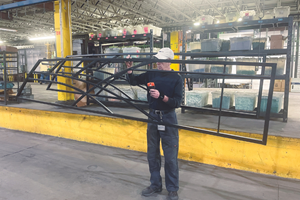Mazak Achieves Faster Throughput With New Powder Coating Line
See the VIDEO as automated powder coating line allows machine tool maker to get products out 74 percent faster.
There is probably no better indicator of how well the U.S. manufacturing industry has rebounded from hard economic times than to walk through Mazak Corp.’s North American manufacturing plant and see all the new machine tool models waiting to be shipped out the door.
Mazak’s North American headquarters, located across the Ohio River from Cincinnati in Florence, Kentucky, was producing 135 machines per month. But with a huge finishing bottleneck, the company knew it could do better.
The machine tool designer and maker recently underwent a major expansion, including a larger powder coating and painting facility, which will increase its capacity to more than 200 machines per month. The expansion began in 2012, on the heels of significant growth in customer demand, and it coincided with more customer service and support in its National Technology Center and Center for Multi-Tasking and Manufacturing Excellence and its North American Parts Center, which will add 200,000 square feet to its campus, bringing the total to more than 800,000 square feet—and making it one of the largest machine tool factories in the U.S.
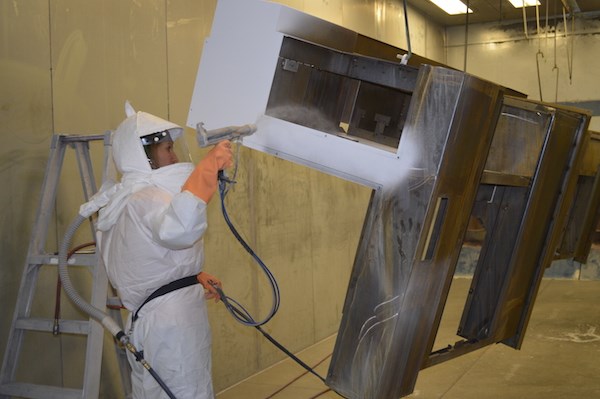
Mazak Corp. achieves faster throughput with new powder coating line.
Evolving Needs
Brian Papke, president of Mazak Corp., says the expansion allows Mazak to more efficiently fulfill customers’ evolving needs for advanced machine tool technology, with many of those customers centered in the energy, aerospace, construction and agriculture equipment, automotive and medical industries.
Part of the manufacturing facility expansion involved moving existing shop production offices to a built-on addition, creating a spacious center aisle within the manufacturing building.
The bonus floor space enabled installation of additional manufacturing equipment, which includes a highly advanced manufacturing cell called Palletech that is unique to the industry and produced by Mazak. The modular system allows dissimilar machine tools to be integrated into the same manufacturing cell.
Opened in 1996, Mazak’s National Technology Center is the hub for the company’s eight Regional Technology Centers. It doubled in size after a 2006 expansion, and, after recent growth, now boasts more than 100,000 square feet, including seven new high bay areas, a second story office section and more square footage for demonstrating Mazak’s technology to its customers.
Increased Capacity
Mazak’s North American Parts Center grew its storage capacity by 25 percent with the addition of two fully-automated vertical lift module storage systems, which boost small-parts capacity by 5,600 parts to more than 50,000 unique part numbers in stock—all available for same-day delivery for 97 percent of the company’s orders.
Papke says that Mazak’s original goal for the U.S. manufacturing campus was to allow it to be completely integrated into the market, thus better serving manufacturers.
“We have maintained our commitment to this goal over the years, which is evident in the sustained growth and expansion of our facilities,” he says. “As are our customers, we remain committed to continuous improvement, and providing them with the resources they need as business evolves.”
A big part of that growth was expanding Mazak industrial coating application processes, which included building a new automated powder coating line and moving an existing batch system to the new addition.
Ben Schawe, Mazak’s vice president of manufacturing, says the previous powder coating line had a much smaller capacity for part sizes, measuring roughly 10 x 5 x 6 feet. The old system had two booths, and with two basic colors, the changeover took about 20 minutes to switch powder colors by shuttling the two different booths in and out.
“We coat special colors on request, so anytime we had a special color, we had to change the whole cartridge out and blow the entire booth down, which took us over an hour,” Schawe says. “The line speed was about five feet per minute, and we wanted to improve on that.”
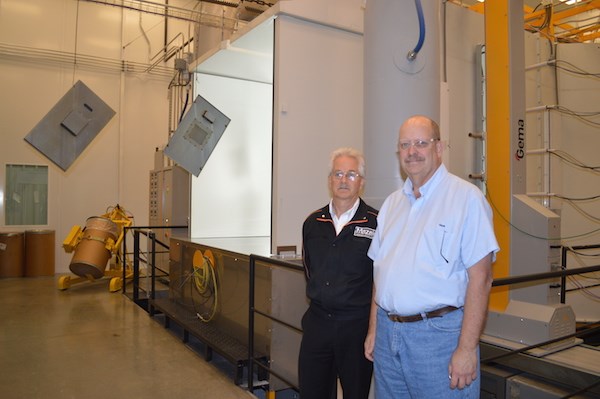
Ben Schawe, left, and Dave Osborne say the new powder coating line at Mazak has sped up production.
Modular Construction
To get a new system designed and implemented, Mazak went back to the company that installed the original equipment, Midwest Finishing Systems, in Mishawaka, Indiana.
MFS specializes in designing, engineering, fabricating and installing powder coating systems in one turn-key approach. The company constructs its systems in a modular way so that it can build the system at its Indiana headquarters and test it before shipment.
The new automated line that MFS designed for the Mazak project is more than 870 feet in length, running on a 3-inch I-beam conveyor, and runs at about 8 feet per minute—more than 60 percent faster than the previous system.
Russ Green, regional sales manager for MFS, says the new line has a work opening size of about 7 x 7 feet, and that the longest part it can handle would be about 16 feet long.
“We knew they wanted to increase their production volumes, and one of the things we looked at was the size of the parts they needed to coat,” Green says. “From there, we could size the system to meet those specifications and any production schedules they were wanting to meet. We went through three or four scenarios based on the floor space before we finally selected one that would work the best.”
That size improvement was great news for Schawe and his team, which included Dave Osborne, Mazak’s fabrication manager, who also oversees the finishing operations. If they had large parts to powder coat previously, it often meant some maneuvering on the shop floor.
Accommodating Large Parts
“We had a stand-alone system that we would manually move parts into, and it could handle the larger parts,” Schawe says. “We still have that system, but it only handles eight or 10 parts that we can’t get into the new system.”
Osborne says the installation started in November 2013, and getting the bigger parts through the system was the impetus for investing in a new line. It went online in July with testing and training. And now: “At 16 feet, we’ve been able to accommodate any part that we currently make in our fabrication shop,” he says.
The new system has 10 OptiFlex Series automatic powder coating guns supplied from Gema (Indianapolis), and includes a light curtain that detects the size of the part entering the booth and only triggers those guns that will be needed to coat the part, thus reducing wasted powder coating. There are also two manual guns run by operators who touch up parts when needed.
Gema’s Joe Mallee says the Mazak application was unique, and to meet the company’s performance criteria, a different approach was required to manage both the application of the coating and the powder recovery process.
“Mazak’s objective was to add automation to powder coat their products, thus increasing productivity and quality while reducing manual coating reinforcement,” Mallee says. “Due to the large size of certain machine center weldments and frames, Mazak chose to incorporate manual coating after the automatic application equipment. Another critical aspect to their performance criteria was the ability to meet increasing demand from their customers to provide more custom color capability.”
Mallee says that given the sheer area of coverage and volume of powder involved to coat Mazak’s products, a multi-color application would only be cost effective if it could be reclaimed with minimum production downtime during the color-change process.
To achieve the desired film thickness and uniformity, as well as the necessary color-change capability, a customized system was required. Specifically, a booth was needed that could maximize automatic application efficiency of the powder, minimize the amount of powder in process, and facilitate quick color changes.
“The uniqueness of the Mazak system is that 10 OptiFlex series automatic guns, mounted on two Gema ZA series reciprocators, are automatically triggered based on product information,” Mallee says. “Target distance for each reciprocator is automatically communicated to provide consistent tip-to-part uniformity, allowing for contouring on the various products coated.”
Once automatically coated, the part enters the manual coating station, which is customized to accommodate two operators and provides “hi-lo” coating capability. To maximize the operator flexibility and minimize the elevation of the conveyor, the entire booth was lowered, allowing the operators to easily go from the lower position of the manual coating station directly onto the plant floor.
“This arrangement allows the operator to stand in a comfortable position and address the underside of certain product geometries, and then proceed to a raised platform for addressing the upper regions of the product when needed,” Mallee says. “If future production capacity is required all four stations may be manned. The advantage offered to the operators is greater visibility and range of motion, ensuring that all products requiring touchup are coated properly.”
The unique cabin configuration coupled with the manual stations was carefully designed so the recovery of the overspray powder from the manual coating station is drawn into the automatic coating section, keeping the powder in process.
Mallee says all oversprayed powder enters into the EquiFlow balanced airflow and is recovered continuously without accumulation, providing Mazak with immediate return of the reclaimed powder, automatically blending it with fresh material using the OptiCenter powder management system.
The OptiSpeeder feed hopper, continuous reclaim and constant balance with virgin powder provides Mazak unparalleled material process equilibrium, improving reclaim powder quality and shortening the color change time of the entire system, he says.
“The biggest gain with the new system is that we went from two booths to one, and now we can change over color in about 30 minutes instead of the hour it took before,” Schawe says.
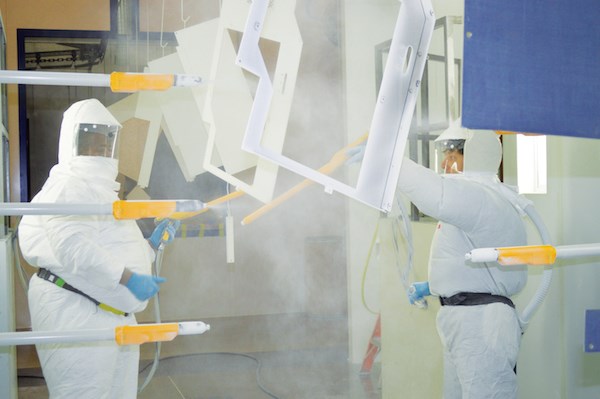
Once automatically coated, the part enters the manual coating station, customized to accommodate two operators and provide “hi-lo” coating capability.
Reducing Heat
One distinctive design feature is that the parts are loaded on the line in one building, then travel through a large opening in a concrete wall to be cleaned, oven dried and moved into the coating line before being cured in another oven.
Green says the wall separation was designed into the system to keep all the heat into one part of the facility and not in the area where parts were loaded, thus keeping that work area cooler.
“The goal was to keep some of the heat out of the main part of the plant,” he says. “We recommended that configuration, and then we had to set up the necessary air makeup back in the curing area.”
Although the area was considered new space, it still presented a challenge for MFS and Mazak to get everything to fit just right; the manufacturing operation had parts coming on and off the line, and the batch system needed to be integrated into the floor plan, too.
“The biggest challenge was getting everything that was needed to fit in a certain corner of the facility,” Green says.
The new system included a 5-stage all stainless steel washer, a 10-minute straight pass dry-off oven, and a 20-minute convection cure oven.
“It is the same process we had before, but we can now handle the larger parts in the cleaning process, too,” Schawe says.
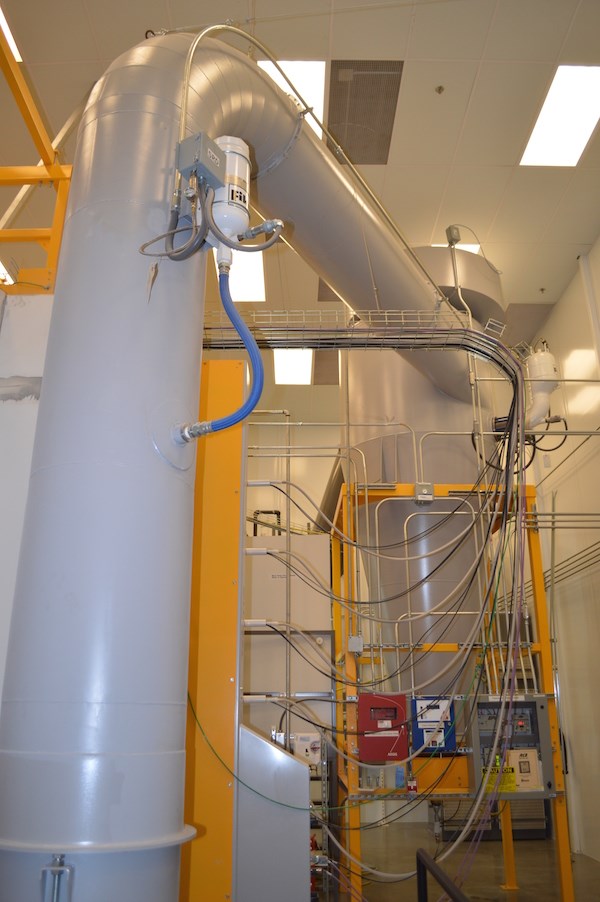
Overspray enters into the EquiFlow balanced airflow and is recovered continuously, providing Mazak with immediate return of the reclaimed powder.
Equipment Upgrade
At the same time as the new system went in, MFS moved the batch system to the coating area. The system was upgraded with a Gorbel manual shuttle system with two bridges and one new stainless steel manual wash station with clear walls that measures 34 feet long, 16 feet wide and more than 14 feet tall.
MFS also installed a new liquid batch booth that is 30 feet long, 12 feet wide and 14 feet high. Green says the work opening on the batch system is 10 by 10 feet, and the longest part it can handle is 30 feet long.
The new coating line was vital to Mazak’s overall goal of increased machine production. Schawe says the manufacturing plant was producing about 135 machines a month before the improvements, but he estimates that it could now go as high as 235 a month—a 74 percent production increase.
“It used to take roughly 121 minutes for a machine to go through the plant, but now it’s about 76 minutes.” he says. “The new line has been a tremendous boost for us.”
For more information on Mazak Corp., visit mazakusa.com. Supplier information: Midwest Finishing Systems, powdercoating.com; Gema, gemapowdercoating.us.
Related Content
Powder Coating Overcomes Post Forming
Six Sigma methodology, open communication, and collaboration produce results for leading boat manufacturer.
Read MoreSelecting the Right Outdoor-Durable Powder Coating
The powder coating industry offers an array of chemistries to provide an excellent match to the manufacturer’s expectations for outdoor durability.
Read More12 Ways to Improve Your Powder Coating Quality
Often overlooked powder coating procedures that can help you elevate your quality, streamline your operations and improve your profitability.
Read MoreProducts Finishing Reveals 2024 Qualifying Top Shops
PF reveals the qualifying shops in its annual Top Shops Benchmarking Survey — a program designed to offer shops insights into their overall performance in the industry.
Read MoreRead Next
Strengthening a Powder Coating Line
Fitness Equipment Maker Cybex Shapes Up Its System In Eight Days.
Read MoreEpisode 45: An Interview with Chandler Mancuso, MacDermid Envio Solutions
Chandler Mancuso, technical director with MacDermid Envio discusses updating your wastewater treatment system and implementing materials recycling solutions to increase efficiencies, control costs and reduce environmental impact.
Read MoreEducation Bringing Cleaning to Machining
Debuting new speakers and cleaning technology content during this half-day workshop co-located with IMTS 2024.
Read More








.jpg;maxWidth=300;quality=90)







